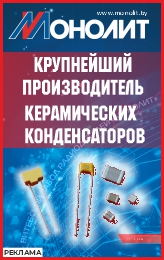The fiber-optic communication lines with wavelength division multiplexing need dynamic stabile lasers with a very narrow spectral line. Lasers with distributed Bragg mirrors best of all meet these requirements.
Теги: fiber-optic communication lines lasers with distributed bragg mirrors волоконно-оптические линии связи лазеры с распределенными брегговскими зеркалами
Radiation spectrum of injection lasers has several longitudinal modes and rather large width (1-5 nm). For many practical applications of lasers the most important task consists in the obtainment of single-frequency mode of generation. Single-frequency lasers are used in fiber-optical communication lines with the wavelength division multiplexing of channels, spectroscopy with high resolution, in fiber-optical sensors, in ecology, in medicine and other areas of science and engineering. One more important peculiarity of semiconductor lasers, which additionally widens the circle of their application, consists in the capability of wide tuning of wavelength within the limits of the whole spectral gain range (20-40 nm).
At the first stages of creation of semiconductor tunable lasers, the laser diodes (LD) with short resonator (100-200 μm) were used. Taking into account the fact that intermodal interval for such emitters is large, the difference in the gain of adjacent modes reaches the significant value. As a result, the radiation spectrum of lasers with short resonator usually has one longitudinal mode. Wavelength tuning for such lasers was performed on the basis of variation of temperature and pump current. Small value of output power, large ohmic and thermal resistances which cause the instability in operation referred to the shortcomings of such lasers.
In fiber-optical communication lines single-frequency lasers with distributed feedback (DFB) obtained the widest circulation.
In these lasers, the feedback which is needed for the generation of laser radiation is formed at the expense of periodical variation of refraction index inside the optical waveguide. In DFB lasers the gain region is located in the medium with periodical variation of refraction index.
This class of lasers has the stable single-frequency operation mode (Fig.1), wide range of radiation wavelength tuning, rather high optical power within wide range of temperatures [1−3].
Watt-ampere characteristics in the range of temperatures of 5 to +80 degrees are shown in Fig.2. The radiation power at fiber output was 10-20 mW. Construction of international unified laser module of “Butterfly” type, which contains active element with distributed feedback, microcooler, feedback photodiode, thermal resistance, single-mode fiber with the retention of polarization and with cylindrical lens, optical resistance, is shown in Fig. 3. The main characteristics of laser modules for the wavelength of 1550 nm are specified in Table 1. The operational life of laser module is not less than one hundred thousand hours.
Thus, single-frequency laser modules with distributed feedback at the wavelength of 1550 nm obtained the widest application in wideband (25 Tbit/s and more) fiber-optical communication lines and fiber-optical sensors, in medical and ecological equipment.
At the first stages of creation of semiconductor tunable lasers, the laser diodes (LD) with short resonator (100-200 μm) were used. Taking into account the fact that intermodal interval for such emitters is large, the difference in the gain of adjacent modes reaches the significant value. As a result, the radiation spectrum of lasers with short resonator usually has one longitudinal mode. Wavelength tuning for such lasers was performed on the basis of variation of temperature and pump current. Small value of output power, large ohmic and thermal resistances which cause the instability in operation referred to the shortcomings of such lasers.
In fiber-optical communication lines single-frequency lasers with distributed feedback (DFB) obtained the widest circulation.
In these lasers, the feedback which is needed for the generation of laser radiation is formed at the expense of periodical variation of refraction index inside the optical waveguide. In DFB lasers the gain region is located in the medium with periodical variation of refraction index.
This class of lasers has the stable single-frequency operation mode (Fig.1), wide range of radiation wavelength tuning, rather high optical power within wide range of temperatures [1−3].
Watt-ampere characteristics in the range of temperatures of 5 to +80 degrees are shown in Fig.2. The radiation power at fiber output was 10-20 mW. Construction of international unified laser module of “Butterfly” type, which contains active element with distributed feedback, microcooler, feedback photodiode, thermal resistance, single-mode fiber with the retention of polarization and with cylindrical lens, optical resistance, is shown in Fig. 3. The main characteristics of laser modules for the wavelength of 1550 nm are specified in Table 1. The operational life of laser module is not less than one hundred thousand hours.
Thus, single-frequency laser modules with distributed feedback at the wavelength of 1550 nm obtained the widest application in wideband (25 Tbit/s and more) fiber-optical communication lines and fiber-optical sensors, in medical and ecological equipment.
Readers feedback

 rus
rus TS_pub
TS_pub technospheramag
technospheramag technospheramag
technospheramag ТЕХНОСФЕРА_РИЦ
ТЕХНОСФЕРА_РИЦ


